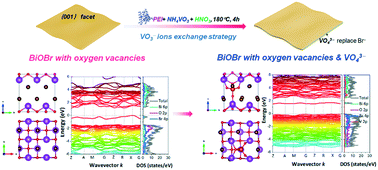Refining the band structure of BiOBr nanosheets through the synergetic effect of VO43− ions replacement and oxygen vacancies for promoted visible-light-driven photocatalysis†
Abstract
Normally, the band structure of a photocatalyst can be tuned by surface oxygen vacancies or element doping, however, employing the synergetic effects of surface oxygen vacancies and oxyacid group replacements to regulate the band structure of the photocatalyst is challenging. Here, the band structure of BiOBr nanosheets was regulated by surface oxygen vacancies and VO3− ions replacement through a hydrothermal VO3− ions exchange route, in which the VO3− transform into VO43− for BiVO4 and BiV1.025O4+x. The crystal phase of the products evolved from BiOBr, BiOBr/BiVO4, BiOBr/BiVO4/BiV1.025O4+x, and BiVO4/BiV1.025O4+x accordingly, when gradually increasing the concentration of VO3− (NH4VO3) from 0.05 to 3.0 mmol. In particular, the BiOBr nanosheets with surface oxygen vacancies and VO43− ion replacement (by adding 0.05 mmol of VO3−) possessing defective states and more negative conduction band potential could promote visible-light-driven photocatalytic performances of organic contaminants due to the effective separation of charge carriers. This work provides new insight into refining the band structure of photocatalysts and evidential proof of a phase transition through oxyacid exchange.

- This article is part of the themed collection: Nanomaterials


 Please wait while we load your content...
Please wait while we load your content...